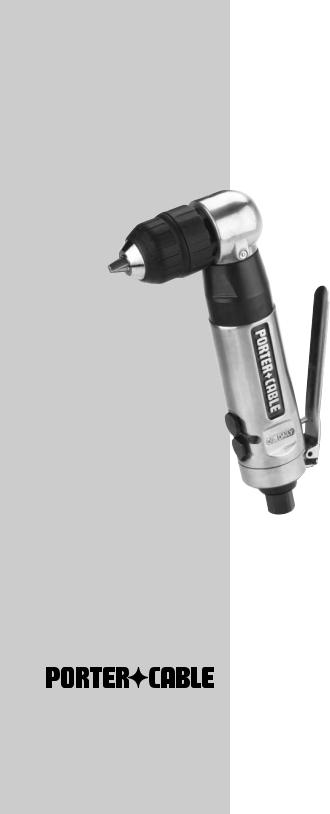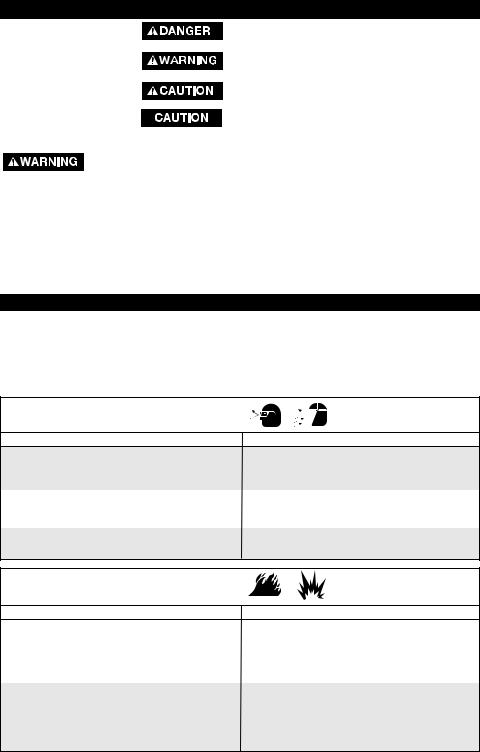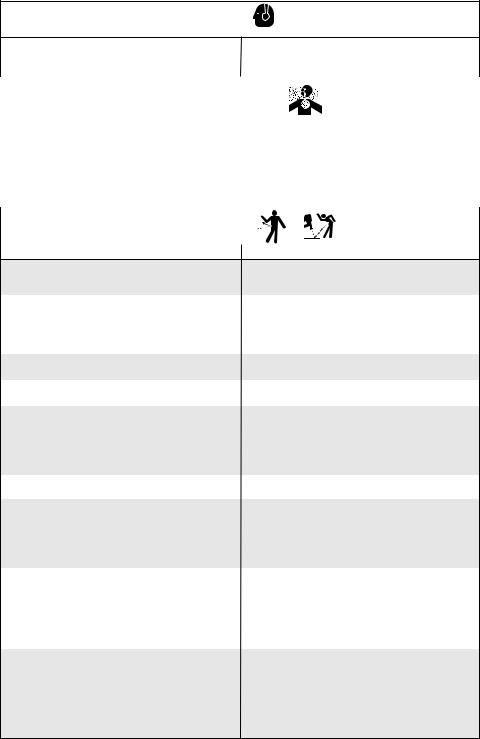Porter-Cable PTD381 User Manual

Instruction manual |
ESPAÑOL: PÁGINA 9 |
|
FRANÇAIS: PAGE 17 |
||
Manual de |
||
|
||
|
||
Instrucciones |
3/8" Drill |
|
Manuel d'instructions |
Taladro de 3/8" |
|
|
Perceuse de 3/8 po |
To learn more about Porter-Cable visit our website at: http://www.porter-cable.com
Para obtener más información sobre Porter-Cable, visite nuestro sitio web en: http://www.porter-cable.com
Pour de plus amples renseignements concernant Porter-Cable, consultez notre site Web à l'adresse suivante: http://www.porter-cable.com
Copyright © 2002 Porter-Cable Corporation
MODEL PTD381
MODELO PTD381
MODÈLE PTD381
IMPORTANT
Please make certain that the person who is to use this equipment carefully reads and understands these instructions before starting operations.
IMPORTANTE
Asegúrese de que la persona que va a usar esta herramienta lea cuidadosamente y comprenda estas instrucciones antes de empezar a operarla.
IMPORTANT
Veuillez vous assurer que la personne qui utilise cet outil lit attentivement et comprend ces instructions avant de commencer à utiliser l'outil.
Part No. D22723-028-3

SAFETY GUIDELINES - DEFINITIONS
This manual contains information that is
important for you to know and understand. This information relates to protecting YOUR SAFETY and PREVENTING EQUIPMENT PROBLEMS. To help you recognize this information, we use the symbols below. Please read the manual and pay attention to these sections.
indicates an imminently hazardous situation which, if not avoided, will result in death or serious injury.
indicates a potentially hazardous situation which, if not avoided, could result in death or serious injury.
indicates a potentially hazardous situation which, if not avoided,may result in minor or moderate injury
used without the safety alert symbol indicates potentially hazardous situation which, if not avoided, may result in property damage.
Some dust created by power sanding, sawing, grinding, drilling, and other construction activities contains chemicals known (to the State of California) to cause
cancer, birth defects or other reproductive harm. Some example of these chemicals are:
●
●
●
lead from lead-based paints
crystalline silica from bricks and cement and other masonry products
arsenic and chromium from chemically-treated lumber
Your risk from these exposures varies, depending on how often you do this type of work. To reduce your exposure to these chemicals: work in a well ventilated area, and work with approved safety equipment, always wear MSHA/NIOSH approved, properly fitting face mask or respirator when using such tools.
When using air tools, basic safety precautions should always be followed to reduce the risk of personal injury.
IMPORTANT SAFETY INSTRUCTIONS
 IMPROPER OPERATION OR MAINTENANCE OF THIS PRODUCT COULD RESULT IN SERIOUS INJURY AND PROPERTY DAMAGE. READ AND UNDERSTAND ALL WARNINGS AND OPERATING INSTRUCTIONS BEFORE USING THIS EQUIPMENT.WHEN USING AIR TOOLS, BASIC SAFETY PRECAUTIONS SHOULD ALWAYS BE FOLLOWED TO REDUCE THE RISK OF PERSONAL INJURY.
IMPROPER OPERATION OR MAINTENANCE OF THIS PRODUCT COULD RESULT IN SERIOUS INJURY AND PROPERTY DAMAGE. READ AND UNDERSTAND ALL WARNINGS AND OPERATING INSTRUCTIONS BEFORE USING THIS EQUIPMENT.WHEN USING AIR TOOLS, BASIC SAFETY PRECAUTIONS SHOULD ALWAYS BE FOLLOWED TO REDUCE THE RISK OF PERSONAL INJURY.
SAVE! IMPORTANT SAFETY INSTRUCTIONS SAVE!
HAZARD
 RISK OF EYE OR HEAD INJURY
RISK OF EYE OR HEAD INJURY
WHAT COULD HAPPEN |
HOW TO PREVENT IT |
•Air powered equipment and power tools are capable of propelling materials such as fasteners, metal chips, saw dust, and other debris at high speed, which could result in serious eye injury.
•Compressed air can be hazardous. The air stream can cause injury to soft tissue areas such as eyes, ears, etc. Particles or objects propelled by the stream can cause injury.
•Tool attachments can become loose or break and fly apart propelling particles at the operator and others in the work area.
•Always wear ANSI approved Z87.1 safety glasses with side shields.
•Never leave operating tool unattended. Disconnect air hose when tool is not in use.
•For additional protection use an approved face shield in addition to safety glasses.
•Make sure that any attachments are securely assembled.
HAZARD
 RISK OF FIRE OR EXPLOSION
RISK OF FIRE OR EXPLOSION
WHAT COULD HAPPEN |
HOW TO PREVENT IT |
•Abrasive tools such as sanders and grinders, rotating tools such as drills, and impact tools such as nailers, staplers, wrenches, hammers, and reciprocating saws are capable of generating sparks which could result in ignition of flammable materials.
•Exceeding the maximum pressure rating of tools or accessories could cause an explosion resulting in serious injury.
•Never operate tools near flammable substances such as gasoline, naptha, cleaning solvents, etc.
•Work in a clean, well ventilated area free of combustible materials.
•Never use oxygen, carbon dioxide or other bottled gases as a power source for air tools.
•Use compressed air regulated to a maximum pressure at or below the rated pressure of any attachments.
•Never connect to an air source that is capable of exceeding 200 psi.
•Always verify prior to using the tool that the air source has been adjusted to the rated air pressure range.
D22723 |
2- ENG |

HAZARD
 RISK OF LOSS OF HEARING
RISK OF LOSS OF HEARING
|
|
|
WHAT COULD HAPPEN |
|
HOW TO PREVENT IT |
|
• |
Long term exposure to noise produced from the opera- |
• |
Always wear ANSI S3.19 hearing protection. |
|
|
|
tion of air tools can lead to permanent hearing loss. |
|
|
|
|
|
|
|
|
|
|
|
|
|
|
|
|
|
|
HAZARD |
|
|
|
|
|
RISK TO BREATHING INHALATION HAZARD |
|
|
|
|
|
|
||
|
|
|
|
|
|
|
|
|
WHAT COULD HAPPEN |
|
HOW TO PREVENT IT |
|
• |
Abrasive tools, such as grinders, sanders, and cut-off |
• |
Always wear MSHA/NIOSH approved, properly fitting |
|
|
|
tools generate dust and abrasive materials which can |
|
face mask or respirator when using such tools. |
|
|
|
be harmful to human lungs and respiratory system. |
|
|
|
|
• |
Some materials such as adhesives and tar, contain |
• |
Always work in a clean, dry, well ventilated area. |
|
|
|
chemicals whose vapors could cause serious injury |
|
|
|
|
|
with prolonged exposure. |
|
|
|
|
|
|
|
|
|
|
|
|
HAZARD |
|
|
|
|
|
RISK OF INJURY |
|
|
|
|
|
|
|
|
|
|
|
|
|
|
|
|
|
WHAT COULD HAPPEN |
|
HOW TO PREVENT IT |
•Tools left unattended, or with the air hose attached can be activated by unauthorized persons leading to their injury or injury to others.
•Air tools can propel fasteners or other materials throughout the work area.
•A wrench or a key that is left attached to a rotating part of the tool increases the risk of personal injury.
•Using inflator nozzles for duster applications can cause serious injury.
•Remove air hose when tool is not in use and store tool in secure location away from reach of children and or untrained users.
•Use only parts, fasteners, and accessories recommended by the manufacturer.
•Keep work area clean and free of clutter. Keep children and others away from work area during operation of the tool.
•Keep work area well lit.
•Remove adjusting keys and wrenches before turning the tool on.
•DO NOT use inflator nozzles for duster applications.
•Air tools can become activated by accident during maintenance or tool changes.
•Air tools can cause the workpiece to move upon contact leading to injury.
•Loss of control of the tool can lead to injury to self or others.
•Poor quality, improper, or damaged tools such as grinding wheels, chisels, sockets, drills, nailers, staplers, etc., can fly apart during operation, propelling particles throughout the work area causing serious injury.
•Fasteners could ricochet or be propelled causing serious injury or property damage.
•Remove air hose to lubricate or add grinding attachments, sanding discs, drills, etc. to the tool.
•Never carry the tool by the hose.
•Avoid unintentional starting. Don't carry hooked-up tool with finger on trigger.
•Repair servicing should be done only by an authorized service representative.
•Use clamps or other devices to prevent movement.
•Never operate tool while under the influence of drugs or alcohol.
•Don't overreach. Keep proper footing and balance at all times.
•Keep handles dry, clean, and free from oil and grease.
•Stay alert. Watch what you are doing. Use common sense. Do not operate tool when you are tired.
•Always use tool attachments rated for the speed of the power tool.
•Never use tools which have been dropped, impacted or damaged by use.
•Use only impact grade sockets on an impact wrench.
•Do not apply excessive force to the tool, let the tool perform the work.
•Never point discharge of tool at self or others.
•Do not pull trigger unless tool contact safety device is against work surface.
•Never attempt to drive fasteners into hard surfaces such as steel, concrete, or tile.
•Take care to avoid driving a fastener on top of another fastener.
•Position tool carefully so that fasteners will be delivered to the proper location.
3- ENG |
D22723 |
